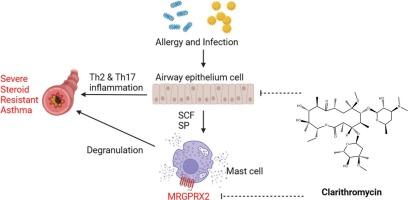Clarithromycin attenuates severe steroid hyporesponsive asthma by regulating type 2/type 17 inflammation balance and inhibiting mast cell activation
IF 3.4
3区 医学
Q2 PHARMACOLOGY & PHARMACY
引用次数: 0
Abstract
Asthma is a global notifiable disease that is mainly treated with glucocorticoids and airway relaxants. Some patients with neutrophilic airway inflammation are not sensitive to glucocorticoids therapy and there is no effective treatment available. Clarithromycin (CLA) is a commonly used macrolide antibiotic in clinical practice and is used in the treatment of lower respiratory tract infections. However, the underlying mechanism remain unclear. The inhibitory effect of CLA on epithelial cells inflammation and mast cells (MCs) activation in vitro or in vivo were measured. LPS/OVA induced severe steroid hyporesponsive asthma (SSHA) mice were used to evaluate CLA relief on pulmonary inflammation, bronchoalveolar lavage fluid (BALF) cytokines release, and airway hyperresponsiveness (AHR). CLA inhibited the secretion of inflammatory mediators from epithelial cells induced by LPS + IL-13 and modulated type 2/type 17 inflammation balance induced by IL-13 + TNF-α or IL-17 A. Besides, CLA inhibited MRGPRX2 induced MCs activation directly in vitro and pseudo-allergic reaction in vivo. Furthermore, the activation and proliferation of MCs incubated with LPS + IL-13 induced epithelial cell supernatant was inhibited when CLA was applied. In vivo study confirmed that CLA attenuated SSHA mice symptoms. CLA has the potential as a therapeutic drug for SSHA by regulating epithelial cells type 2/type 17 inflammation balance and inhibiting mast cell activation.

克拉霉素通过调节2/ 17型炎症平衡和抑制肥大细胞活化来减轻严重类固醇性低反应性哮喘。
哮喘是一种全球法定疾病,主要用糖皮质激素和气道松弛剂治疗。一些中性粒细胞性气道炎症患者对糖皮质激素治疗不敏感,目前尚无有效的治疗方法。克拉霉素(CLA)是临床常用的大环内酯类抗生素,用于治疗下呼吸道感染。然而,其潜在机制尚不清楚。在体外和体内观察CLA对上皮细胞炎症和肥大细胞(MCs)活化的抑制作用。采用LPS/OVA诱导的严重类固醇低反应性哮喘(SSHA)小鼠,评价CLA对肺部炎症、支气管肺泡灌洗液(BALF)细胞因子释放和气道高反应性(AHR)的缓解作用。CLA抑制LPS + IL-13诱导的上皮细胞炎症介质的分泌,调节IL-13 + TNF-α或IL-17 A诱导的2型/ 17型炎症平衡。CLA在体外直接抑制MRGPRX2诱导的MCs活化和体内假过敏反应。此外,用LPS + IL-13诱导的上皮细胞上清液孵育的MCs的活化和增殖受到CLA的抑制。体内研究证实CLA能减轻SSHA小鼠的症状。CLA通过调节上皮细胞2型/ 17型炎症平衡和抑制肥大细胞活化,有潜力成为SSHA的治疗药物。
本文章由计算机程序翻译,如有差异,请以英文原文为准。
求助全文
约1分钟内获得全文
求助全文
来源期刊
CiteScore
6.80
自引率
2.60%
发文量
309
审稿时长
32 days
期刊介绍:
Toxicology and Applied Pharmacology publishes original scientific research of relevance to animals or humans pertaining to the action of chemicals, drugs, or chemically-defined natural products.
Regular articles address mechanistic approaches to physiological, pharmacologic, biochemical, cellular, or molecular understanding of toxicologic/pathologic lesions and to methods used to describe these responses. Safety Science articles address outstanding state-of-the-art preclinical and human translational characterization of drug and chemical safety employing cutting-edge science. Highly significant Regulatory Safety Science articles will also be considered in this category. Papers concerned with alternatives to the use of experimental animals are encouraged.
Short articles report on high impact studies of broad interest to readers of TAAP that would benefit from rapid publication. These articles should contain no more than a combined total of four figures and tables. Authors should include in their cover letter the justification for consideration of their manuscript as a short article.

 求助内容:
求助内容: 应助结果提醒方式:
应助结果提醒方式:


